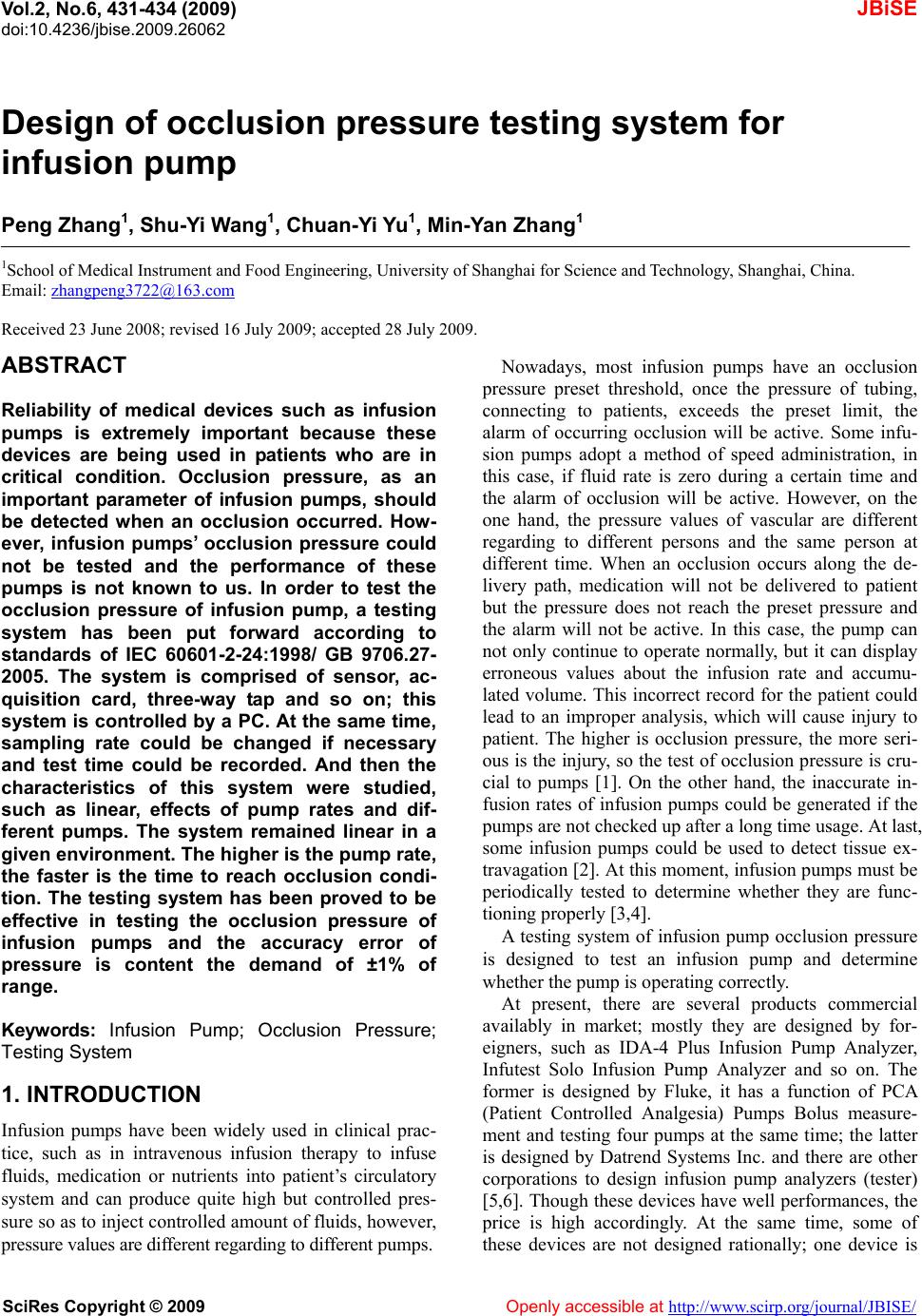
Vol.2, No.6, 431-434 (2009)
doi:10.4236/jbise.2009.26062
SciRes Copyright © 2009 Openly accessible at http://www.scirp.org/journal/JBISE/
JBiSE
Design of occlusion pressure testing system for
infusion pump
Peng Zhang1, Shu-Yi Wang1, Chuan-Yi Yu1, Min-Yan Zhang1
1School of Medical Instrument and Food Engineering, University of Shanghai for Science and Technology, Shanghai, China.
Email: zhangpeng3722@163.com
Received 23 June 2008; revised 16 July 2009; accepted 28 July 2009.
ABSTRACT
Reliability of medical devices such as infusion
pumps is extremely important because these
devices are being used in patients who are in
critical condition. Occlusion pressure, as an
important parameter of infusion pumps, should
be detected when an occlusion occurred. How-
ever, infusion pumps’ occlusion pressure could
not be tested and the performance of these
pumps is not known to us. In order to test the
occlusion pressure of infusion pump, a testing
system has been put forward according to
standards of IEC 60601-2-24:1998/ GB 9706.27-
2005. The system is comprised of sensor, ac-
quisition card, three-way tap and so on; this
system is controlled by a PC. At the same time,
sampling rate could be changed if necessary
and test time could be recorded. And then the
characteristics of this system were studied,
such as linear, effects of pump rates and dif-
ferent pumps. The system remained linear in a
given environment. The higher is the pump rate,
the faster is the time to reach occlusion condi-
tion. The testing system has been proved to be
effective in testing the occlusion pressure of
infusion pumps and the accuracy error of
pressure is content the demand of ±1% of
range.
Keywords: Infusion Pump; Occlusion Pressure;
Testing System
1. INTRODUCTION
Infusion pumps have been widely used in clinical prac-
tice, such as in intravenous infusion therapy to infuse
fluids, medication or nutrients into patient’s circulatory
system and can produce quite high but controlled pres-
sure so as to inject controlled amount of fluids, however,
pressure values are different regarding to different pumps.
Nowadays, most infusion pumps have an occlusion
pressure preset threshold, once the pressure of tubing,
connecting to patients, exceeds the preset limit, the
alarm of occurring occlusion will be active. Some infu-
sion pumps adopt a method of speed administration, in
this case, if fluid rate is zero during a certain time and
the alarm of occlusion will be active. However, on the
one hand, the pressure values of vascular are different
regarding to different persons and the same person at
different time. When an occlusion occurs along the de-
livery path, medication will not be delivered to patient
but the pressure does not reach the preset pressure and
the alarm will not be active. In this case, the pump can
not only continue to operate normally, but it can display
erroneous values about the infusion rate and accumu-
lated volume. This incorrect record for the patient could
lead to an improper analysis, which will cause injury to
patient. The higher is occlusion pressure, the more seri-
ous is the injury, so the test of occlusion pressu re is cru-
cial to pumps [1]. On the other hand, the inaccurate in-
fusion rates of infusion pumps could be generated if the
pumps are not checked up after a long time usage. At last,
some infusion pumps could be used to detect tissue ex-
tra vag at io n [ 2]. A t th is mo me nt , infu s ion pu mps mus t b e
periodically tested to determine whether they are func-
tioning pr o perly [3,4].
A testing system of infusion pump occlusion pressure
is designed to test an infusion pump and determine
whether the pump is operating correctly.
At present, there are several products commercial
availably in market; mostly they are designed by for-
eigners, such as IDA-4 Plus Infusion Pump Analyzer,
Infutest Solo Infusion Pump Analyzer and so on. The
former is designed by Fluke, it has a function of PCA
(Patient Controlled Analgesia) Pumps Bolus measure-
ment and testing four pumps at the same time; the latter
is designed by Datrend Systems Inc. and there are other
corporations to design infusion pump analyzers (tester)
[5,6]. Though these devices have well performances, th e
price is high accordingly. At the same time, some of
these devices are not designed rationally; one device is